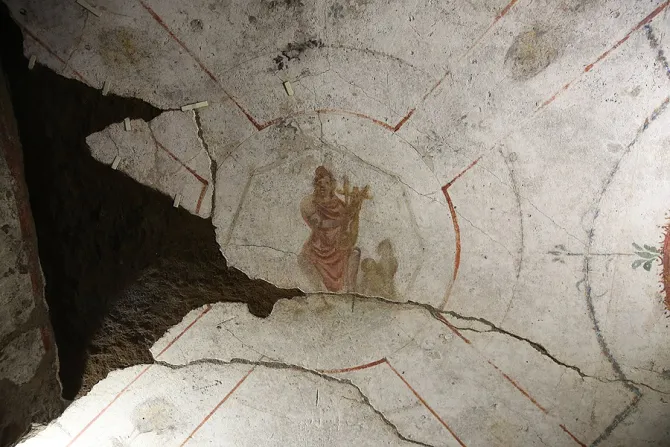Rome, Italy, Jun 5, 2017 / 12:42 pm
Adorning the crypts hidden among Rome's catacombs are frescoes which reveal 1,600 year-old history, as well as the life of early Christians, which are regaining vividness through new technology.
The paintings had been masked by a veil of algae and calcium deposits, and blackened by the smoke of oil lamps until lasers were used to strip the paintings of centuries of grime without damaging their integrity.
"Until recently, we weren't able to carry out this sort of restoration – if we had done it manually we would have risked destroying the frescoes," said the head of the restoration project, Barbara Mazzei, in a comment to The Telegraph May 30.
"When we started work, you couldn't see anything – it was totally black. Different wavelengths and chromatic selection enabled us to burn away the black disfiguration without touching the colors beneath."
About a dozen crypts out of the 70 buried in the Catacombs of St Domitilla have been restored so far. The underground labyrinth extends 10 miles, and is decorated with both Christian and pagan images which demonstrate the process of conversion from Roman paganism to Christianity. The frescoes were painted around the year 360.
"It's a fusion of older pagan symbols with new Christian images. The family had only recently converted to Christianity," said Mazzei.
The superintendent of the Pontifical Commission for Sacred Archaeology, Fabrizio Bisconti, said wealthier Romans were among the last to convert to Christianity.
Shortly before the frescoes were painted, Christians were hunted and killed – including Saints Nerius and Achilleus, whose basilica sits above the crypts and is the entrance to the catacombs.
These two Roman soldiers of the imperial guard were martyred for confessing their faith. They were victims to the military persecutions conducted by the Emperor Diocletian at the very beginning of the fourth century – about 60 years before the frescoes were painted.


